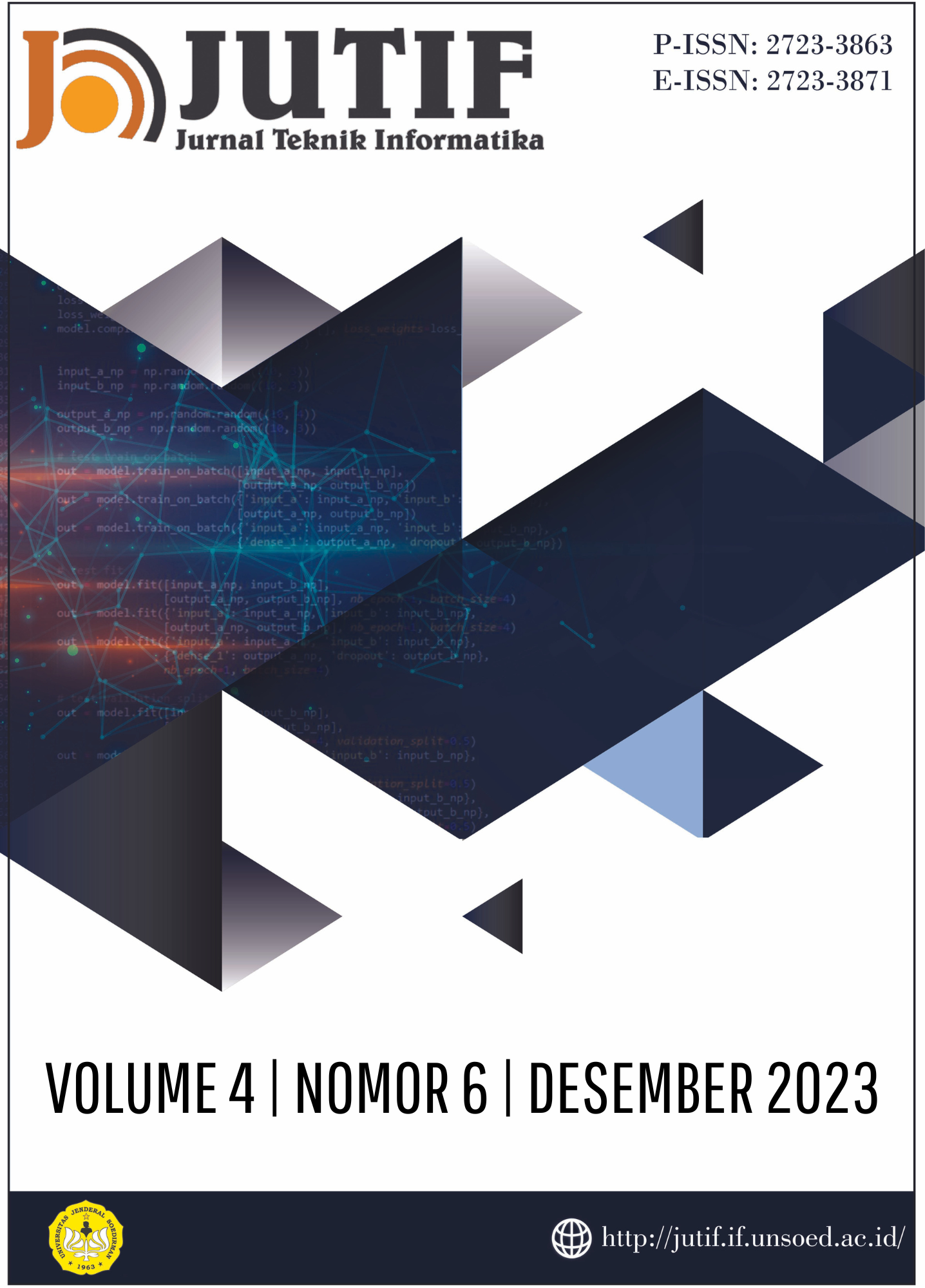CLASSIFICATION OF THE LEVEL OF SUGAR CONTENT IN PAPAYA FRUIT BASED ON COLOR FEATURES USING ARTIFICIAL NEURAL NETWORK
DOI:
https://doi.org/10.52436/1.jutif.2023.4.6.733Keywords:
artificial neural networks, classification, color, papaya, RGBAbstract
Papaya (Carica papaya L) is consumed by many people because it is beneficial for health. Along with increasing consumption or enthusiasts of papaya, the quality of papaya needs to be considered. One of the determining factors of the quality of papaya is its physical characteristics, which can be seen from its color, shape, and texture. Papaya of good quality has a delicious and sweet taste. The sweet taste of papaya is certainly influenced by the sugar content contained in it. However, to determine the sugar content in papaya is only done by human assessment based on its physical characteristics, this assessment is often less accurate. With a system that can determine the sugar content in papaya, it will make it easier for farmers to sort papaya fruit. Therefore, in this study, it is proposed to classify the level of sugar content in papaya based on color features using an Artificial Neural Network. The proposed method consists of 5 stages, namely, image acquisition, preprocessing, segmentation with the Otsu method, morphological operations, and classification with artificial neural networks. The number of papaya datasets used is 300 images which are divided into 3 classes, low class, medium class, and tal class. Based on the results of the tests that have been carried out, an accuracy of 92.85% is obtained for the training data, and for the test data, an accuracy of 100% is obtained. These results indicate that the proposed method can classify the level of sugar content in papaya fruit accurately.
Downloads
References
S. Febjislami, K. Suketi, and R. Yunianti, “Karakterisasi Morfologi Bunga, Buah, dan Kualitas Buah Tiga Genotipe Pepaya Hibrida,” Bul. Agrohorti, vol. 6, no. 1, pp. 112–119, 2018, doi: 10.29244/agrob.v6i1.17488.
A. Aminudin, “Klasifikasitingkat Kematangan Buah Pepaya Menggunakan Metode K-Nearest Neighborberdasarkan Warna Kulit Buah,” pp. 3–15, 2019.
R. Prihatiningtyas, A. S. S, and N. H. Wijaya, “Analisis Peningkatan Kualitas pada Rantai Pasok Buah Pepaya Calina,” J. Manaj. dan Organ., vol. 6, no. 3, p. 206, 2016, doi: 10.29244/jmo.v6i3.12609.
N. Arifiya, Y. A. Purwanto, and I. W. Budiastra, “Analisis Perubahan Kualitas Pascapanen Pepaya Varietas IPB9 pada Umur Petik yang Berbeda,” J. Keteknikan Pertan., vol. 3, no. 1, pp. 41–48, 2015.
M. L. Taris, W. D. Widodo, and K. Suketi, “Kriteria Kemasakan Buah Pepaya (Carica papaya L.) IPB Callina dari Beberapa Umur Panen,” J. Hortik. Indones., vol. 6, no. 3, p. 172, 2015, doi: 10.29244/jhi.6.3.172-176.
R. M. González-Reza, D. Quintanar-Guerrero, A. Del Real-López, E. Piñon-Segundo, and M. L. Zambrano-Zaragoza, “Effect of sucrose concentration and pH onto the physical stability of β-carotene nanocapsules,” Lwt, vol. 90, no. December 2017, pp. 354–361, 2018, doi: 10.1016/j.lwt.2017.12.044.
R. A. Anggreini, S. Winarti, and T. Heryanto, “Pengaruh Suhu, Lama Waktu Pemanasan, pH, Garam dan Gula Terhadap Kestabilan Karotenoid Licuala,” J. Teknol. Pangan, vol. 12, no. 2, pp. 82–86, 2018, doi: 10.33005/jtp.v12i2.1292.
F. Fahmi, Eliyani, and Tulus, “IMAGE PROCESSING Pengenalan Tingkat Kematangan Buah Pepaya Paya Rabo Menggunakan Pengolahan Citra Berdasarkan Warna RGB Dengan K-Means Clustering,” Singuda Ensikom, vol. 1, no. Snastikom, pp. 1–6, 2013.
M. L. Firdhaus, F. Romadlon, and F. M. Wibowo, “Accuracy of sucrose level estimation on papaya ripeness degree determination using RGB value based on mobile application.,” … Manaj. Agroindustri, vol. 8, pp. 79–86, 2019, [Online]. Available: https://www.cabdirect.org/cabdirect/abstract/20193483695
F. Wibowo, A. Harjoko “Klasifikasi Mutu Pepaya Berdasarkan Ciri Tekstur GLCM Menggunakan Jaringan Saraf Tiruan,” J. Ilmu Komputer dan Informatika., vol.3, no.2, pp. 100–104, 2017.
F. Wibowo, D. K. Hakim, and S. Sugiyanto, “Pendugaan Kelas Mutu Buah Pepaya Berdasarkan Ciri Tekstur Glcm Menggunakan Algoritma K-Nearest Neighbors,” J. Nas. Pendidik. Tek. Inform., vol. 7, no. 1, p. 100, 2018, doi: 10.23887/janapati.v7i1.12991.
M. Ezar, A. Rivan, and J. Suherman, “Penentuan Mutu Buah Pepaya California ( Carica Papaya L .) Menggunakan Fuzzy Mamdani,” vol. 12, no. 2, pp. 76–83, 2020.
A. Firlansyah, A. B. Kaswar, and A. A. N. Risal, “Klasifikasi Tingkat Kematangan Buah Pepaya Berdasarkan Fitur Warna Menggunakan Jaringan Syaraf Tiruan,” Techno Xplore J. Ilmu Komput. dan Teknol. Inf., vol. 6, no. 2, pp. 55–60, 2021.
M. E. Al Rivan, M. Arman, and W. Kennedy, “Penentuan Kualitas Buah Pepaya California Menggunakan Metode K-Nn,” Jusikom J. Sist. Komput. Musirawas, vol. 6, no. 1, pp. 1–8, 2021, doi: 10.32767/jusikom.v6i1.1175.
N. D. Miranda, L. Novamizanti, and S. Rizal, “Convolutional Neural Network Pada Klasifikasi Sidik Jari Menggunakan Resnet-50,” J. Tek. Inform., vol. 1, no. 2, pp. 61–68, 2020, doi: 10.20884/1.jutif.2020.1.2.18.
D. R. Anamisa, “Rancang Bangun Metode OTSU Untuk Deteksi Hemoglobin,” S@Cies, vol. 5, no. 2, pp. 106–110, 2015, doi: 10.31598/sacies.v5i2.64.



























